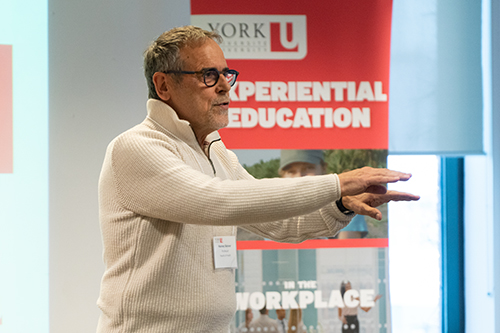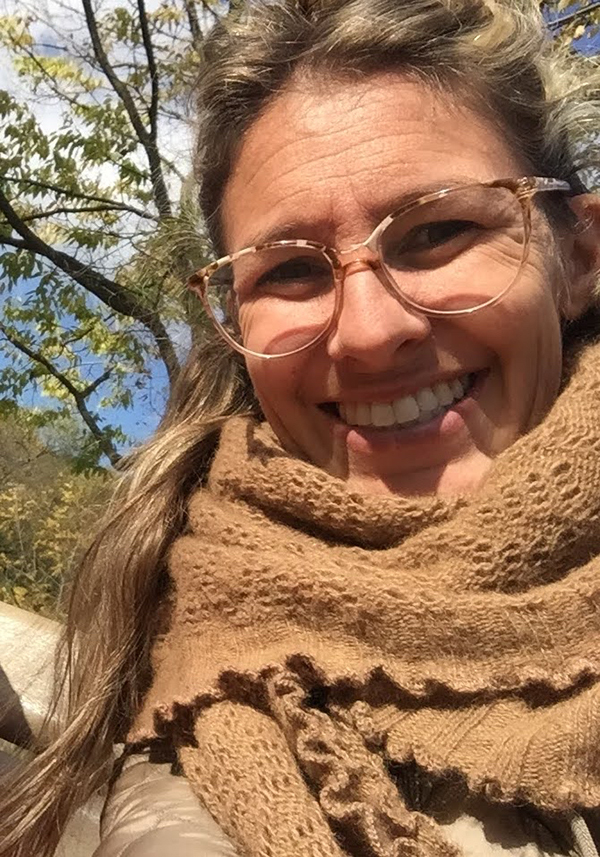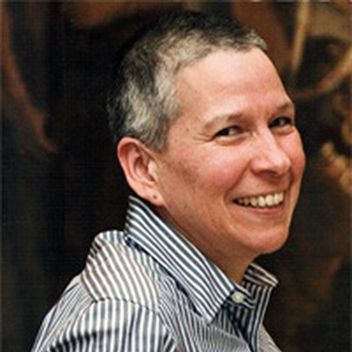By Elaine Smith
Rest, Renew, Revitalize was the theme of the annual Teaching in Focus (TiF) conference at York, and the May 11 and 12 event began as it meant to proceed: by showing faculty members how to take a break and re-energize themselves.
Professor Harvey Skinner’s keynote address had faculty members out of their chairs, doing some Qi Gong deep breathing and some standing exercises that were a way of relaxing the mind and giving the body the energy it needed to focus on the day’s activities. The 10-minute regimen is something that Skinner, a professor of psychology and global health and the founding dean of the Faculty of Health, has done to begin his classes and the difference it made was palpable.

“I believe in interactive experiential learning,” said Skinner as he led the exercises. “Nature never hurries us, yet we’re always trying to rush. We need to be concerned about our overall wellness. We need to be at ease, energized and focused for learning, yet we’re being bombarded by all kinds of news that leaves students feeling depressed about the future.”
He works actively to offer an antidote to these depressed feelings, partly through the energizing regimen, partly through creating connections among the students. In addition to the regimen, Skinner does a quick Zoom poll of his students to see how they are feeling each day and builds in time at the start of his classes for students to meet – virtually or in person – in pairs so they can get to know each other. During his classes, he incorporates learning circles for group work that counts for 30 per cent of a student’s grade and he also requires them to create a personal plan for their health and development, appropriate in a psychology course.
Skinner offered tips for colleagues who wanted inject renewal and revitalization into their own classes, including:
- Begin with yourself – you can’t heal others unless you have a way of rejuvenating yourself.
- Break your online presentations into chunks of no more than 10 minutes and every 30 minutes, make time to stretch and stand.
- Listen to your students; take the pulse of what they are thinking a feeling and make adjustments.
- Take risks; step out of your comfort zone and be inspirational.
Skinner’s keynote kicked off a conference that was held virtually this year, organized by the Teaching Commons (TC) under the aegis of Professor Will Gage, associate vice-president, teaching and learning, who jokingly introduced the speaker as “my much older brother.”

Gage also welcomed the attendees, saying, “This conference is a wonderful opportunity to discuss innovations in teaching and learning at York University and elsewhere, including many of the lessons we’ve learned during the pandemic. It’s an excellent chance for us to share our stories, celebrate new ideas and look back at a challenging time.”
The virtual format allowed the TC to open the conference to others outside York University, and the event drew 114 attendees over the two days, 15 of them from other institutions such as Kings College London (U.K.), Carleton University in Ottawa and Bow Valley College in Alberta. Attendees could choose from among numerous concurrent sessions over the two-day period.
A number of sessions focused on restorative practices used in the classroom, including a talk by Jessica Vorstermans, an assistant professor of critical disability studies, titled “Centering Care and Access in a Large Undergraduate Course.” Vorstermans discussed the importance of building trust with the students, noting, “You can’t build access from a policing mindset.” Her suggestions for making the course more accessible to students included offering deadline flexibility by offering a seven-day extension automatically upon request, no questions asked; giving feedback in advance of a major assignment by reviewing the students’ outlines; and offering assessment in multiple formats so the students could choose something that suited their skills: infographics, podcasts, videos, etc.

“You need to build classrooms that are sites of liberation, not control,” said Vorstermans.
Teaching in a Time of Exhaustion was another topic addressed by a variety of faculty members. For example, Ken McBey, a professor of human resources, gave a talk titled, “Team Teaching in Synchronous Online Courses,” a presentation he created with his colleague, Professor Len Karakowsky. Having taught online for years, the pair have discovered keys to team teaching success, including: compatibility among team members; a shared commitment to course success; support from the institution/Faculty; and a desire to ignite the students’ thirst for knowledge.
The third recurring topic was called Welcome to My Classroom, detailing a success approach used by a faculty member. Noah Lemish, an assistant professor of music, told attendees how he worked remotely with a virtual jazz ensemble, “radically reimagining” the course to involve the students in the production aspect of musical performance. The five members of the ensemble learned to record online and produce a combined sound using layered recording and tracking, techniques that have been used in the recording industry for decades. In addition to developing those skills, Lemish found other unexpected outcomes, such as growth in the students’ abilities to focus on details, listen critically and cultivate musicianship. He was so pleased that he plans to incorporate production into the course even when it is taught in person.

On the second day of the conference, attendees were invited to visit Kumospace, a virtual cafeteria, to expose themselves to new technology. Afterward, Faculty of Education Professor Susan Dion, associate vice-president, Indigenous initiatives, and her PhD students offered a closing keynote address that shared insights into the need for teaching spaces that are informal and adaptable and discussed ways to make spaces better for collaboration.
Geneviève Maheux-Pelletier, director of the Teaching Commons, said that, as always, participants came away inspired by the creativity and dedication of their colleagues and the ideas about reframing the teaching-learning relationship.
“The intent is to have participants leave TiF thinking about what they have learned that they can adapt to their own classrooms to make them inviting places that are so important to allow for conversations to happen,” said Maheux-Pelletier.
“This has been my favourite TiF conference ever,” she added. “The student focus brought a different tone to the event that was compassionate and heartwarming.”


